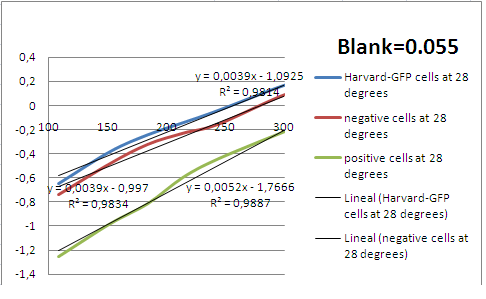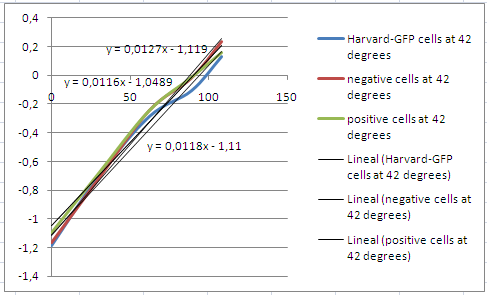Team:Imperial College London/Wetlab/Results/Thermoinduction
From 2009.igem.org

Contents |
Experiment Rationale
To investigate the behaviour of the lamda-cI thermoinducible promoter and show that when temperature is low (at 28 degrees Celsius), there is low fluorescence output. This shows that the genome deletion module is repressed. When temperature is raised to 42 degrees Celsius, fluorescence increases, indicating that the repression is lifted. We are looking at both absorbance and fluorescence data. This analysis serves to characterize the construct [http://partsregistry.org/wiki/index.php/Part:BBa_K200022 BBa_K200022], submitted by Harvard last year.
Summary of method
In order to characterize the thermoinducible promoter, absorbance (optical density) and fluoresence data were recorded over time for:
- Cells containing the BBa_K200022 construct: The thermoinducible promoter.
- Positive control cells: Containing the [http://partsregistry.org/Part:BBa_I13522 BBa_I13522], acting as a baseline comparison by constitutively expressing GFP.
- Negative control cells: These contain the thermoinducible promoter on its own ( [http://partsregistry.org/Part:BBa_K098995 BBa_K098995]) with no GFP attached to it.
Absorbance data
Understanding of the fluorescence data requires normalization with cell growth data, in the form of optical density (absorbance).
28 degrees Celsius
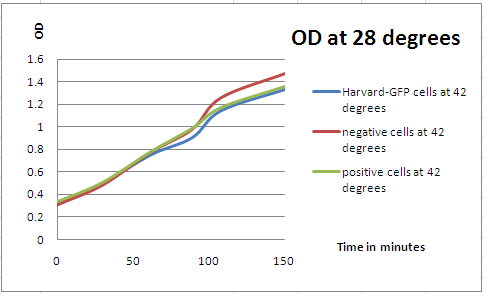
Figure 1: Absorbance at 28 degrees Celsius
42 degrees Celsius
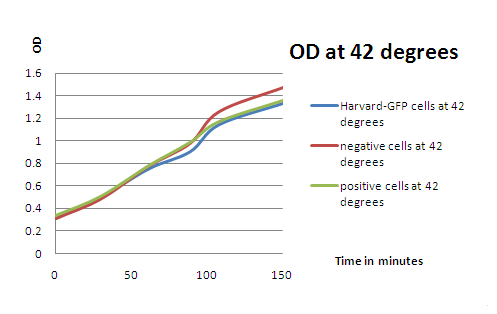
Figure 2: Absorbance at 42 degrees Celsius
Plotting raw absorbance data on its own does not provide sufficient information about the effects of temperature on our system. Therefore, further analysis is required. This includes recording the variation in absorbance of the blank well (containing only the M9 medium) and normalizing absorbance data against the latter to spot ay possible trends in growth rate variations at different temperatures.
Variation in absorbance of the blank
Figure 3 shows that the level of variation in the blank absorbance is within a narrow range (0.05-0.09). However, we cannot immediately assume that it is constant, given that we are dealing with relatively low Optical density values.
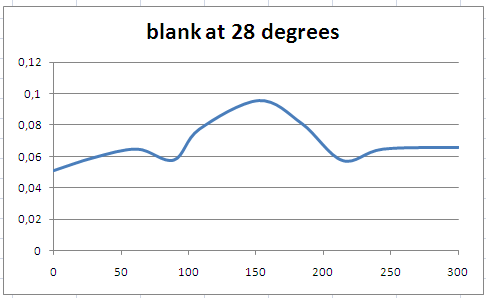
Figure 3: Variation in absorbance of the blank well over time at 28 ºC
In order to take into account this variation, the growth rate of the curves was computed for different values within the range, and the purpose was to decide if this variation had a significant impact on growth rate.
 Figure 4: Variation in absorbance of the blank well over time at 42 ºC
Figure 4: Variation in absorbance of the blank well over time at 42 ºC
Calculation of growth rate of the population for varying blank levels
28 ºC
- Growth rate variation is low for different blank values(0.004-0.005)
- See figure 5 for an example.
- The growth rate of the culture seems to be constant at the values mentioned (0.004 to 0.005 /min) but the positive control seems to be higher. We believe that this variation is due to noise.
42 ºC
- The linear trend in variation of the blank can be explained due to evaporation effects. In this case, the variation was accounted for directly, so it was unnecessary to evaluate the growth rate for different blank values.
- The y-intercept in the plot is not reliable but the trend is apparent.
- We can observe exponential growth for the first 100 minutes (figure 6) at a rate of roughly 0.012 /min.
Conclusion
Cells grow faster at 42 ºC than at 28 ºC.
Conclusion
 "
"
